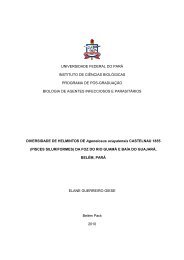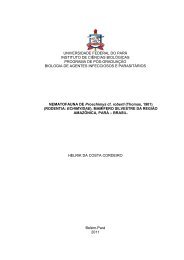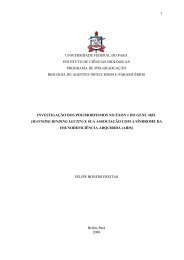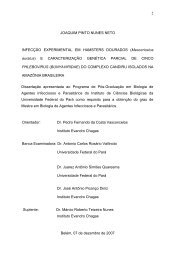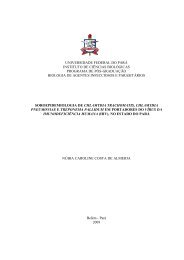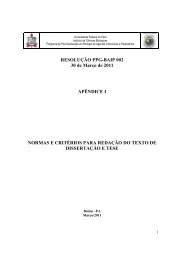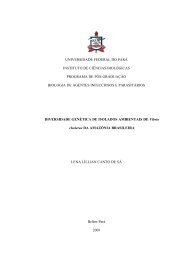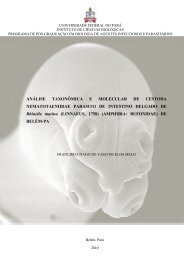adriano penha furtado - BAIP - Universidade Federal do Pará
adriano penha furtado - BAIP - Universidade Federal do Pará
adriano penha furtado - BAIP - Universidade Federal do Pará
Create successful ePaper yourself
Turn your PDF publications into a flip-book with our unique Google optimized e-Paper software.
ABSTRACT<br />
Filarids are elongate and filiforms nematodes parasites. Canids filarids<br />
parasites belong to the Onchocercidae Family and are represented mainly by<br />
Genus Acanthocheilonema, Dipetalonema and Dirofilaria. These filarids<br />
develop in different places in the vertebrate host, and need for haematophagus<br />
invertebrate host to complete your cycle. Different infection levels can occur,<br />
since assintomatic, until the death of <strong>do</strong>g. The filarids parasites of <strong>do</strong>gs are<br />
found mainly in the region between the tropics. In the Amazon region a little is<br />
known about the distribution of these parasites, and until this moment, a study<br />
of distinguishing diagnosis was not performed. With this objective, we choose<br />
two cities in the Marajó Island (Salvaterra and São Sebastião da Boa Vista) and<br />
carry through a epidemiologic, morphologic and molecular studies. The<br />
percentage of microfilaremics <strong>do</strong>gs was of 37.34% in Salvaterra and 6.67% in<br />
São Sebastião da Boa Vista, resulting in a total prevalence of 32.45%.<br />
Analyzing the morphologic characteristics of the collected adult filarids, we<br />
concluded that these worms are of the Dirofilaria immitis species. For analysis<br />
of genic region, we conclude that the microfilariaes found in the <strong>do</strong>gs blood<br />
studied are also D. immitis species, and that these <strong>do</strong>gs had not presented<br />
mixing infection.<br />
9



